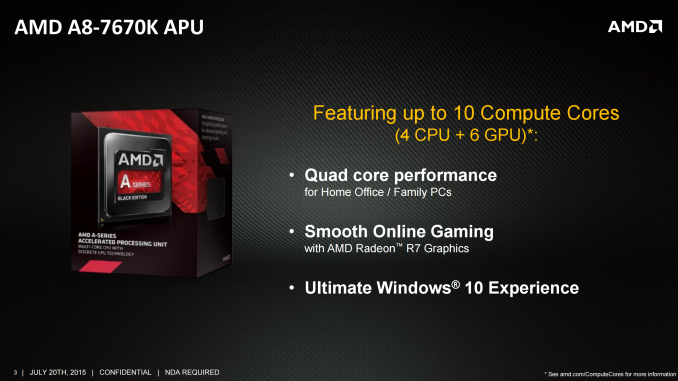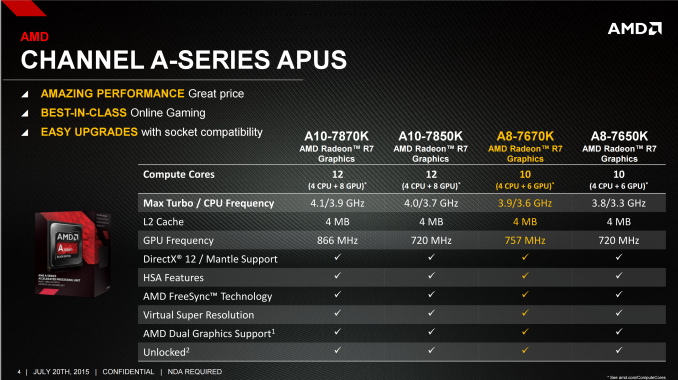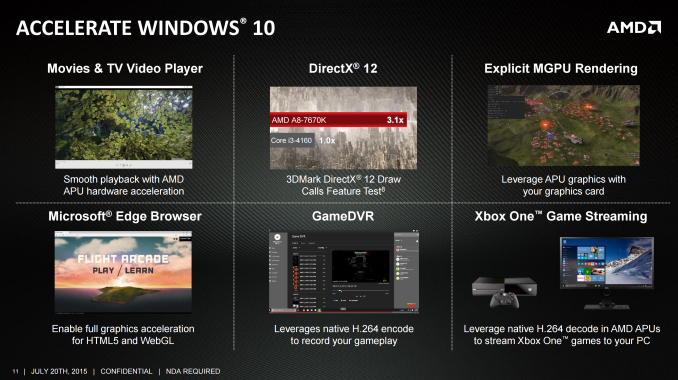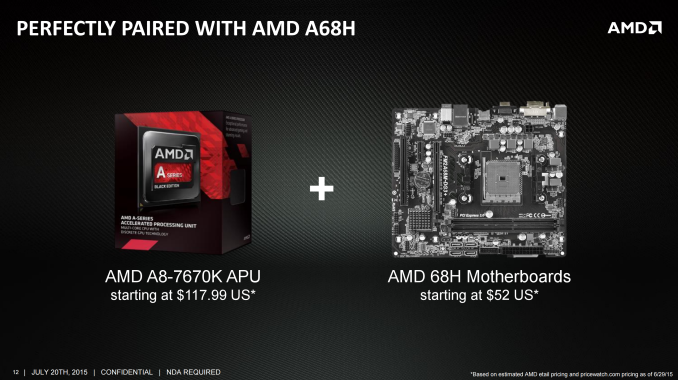AMD Launches the A8-7670K: Filling in the Gaps
by Ian Cutress on July 20, 2015 5:40 PM EST
AMD and Intel, in the last few years, have taken different approaches to how many CPUs enter the mainstream line of the market. Intel has historically had a large product stack, with processors at almost every frequency varying by 100 MHz and slowly rising in core count as well as cache and integrated graphics. AMD’s approach on the other hand is to release a handful of new models every quarter, initially covering the bases on day one and slowing updating the mid points (as well as new high end models) as a lithography node improves in yield and performance and the design matures. We recently took a look at the last launch, the AMD A10-7870K, as well as one at the beginning of the year in the shape of the A8-7650K. The A10-7870K was the first in a line known as the Kaveri Refresh models, or as per AMD’s internal codename ‘Godavari’. The A8-7670K is the second iteration of this line.
The Kaveri Refresh line, or so we are told, is a result of an improved production methodology for better frequency/voltage characteristics and better binning. In the case of the A10-7870K, we were told that the CPU has a minor +0.05 volt increase in the average stock voltage to account for the extra frequency, but due to the improvements the TDP remained the same (95W). In this circumstance, AMD improves on the A8-7650K with an extra 300 MHz to the base frequency (usually the main TDP killer) and an extra 100 MHz on the turbo. This is combined with a 37 MHz increase in the graphics side of the equation, again within the same TDP.
We covered a lot in the A10-7870K review which also applies here to the A8-7670K, although the A8 follows the other A8 APUs by having six compute units for the graphics, or 384 SPs. As AMD does not have a new mainstream desktop APU launch for Windows 10, the current stack of Kaveri and Kaveri Refresh APUs are going to be the focus for AMD, especially with back-to-school sales late in the summer. As a result, a good portion of the press release for the A8-7670K revolves around the use of AMD’s GCN architecture and its alignment to AMD’s mainstream graphics cards, allowing any software that is accelerated by one to be accelerated by the other. As shown above, this includes video playback, DirectX 12, accelerated video encoding and streaming as well.
| AMD Kaveri Lineup | ||||||||
| A10- 7870K |
A10- 7850K |
A10- 7800 |
A10- 7700K |
A8- 7670K |
A8- 7650K |
A8- 7600 |
X4 860K |
|
| Price | $137 | $134 | $131 | $120 | $118 | $104 | $89 | $85 |
| Modules | 2 | 2 | 2 | 2 | 2 | 2 | 2 | 2 |
| Threads | 4 | 4 | 4 | 4 | 4 | 4 | 4 | 4 |
| Core Freq. (GHz) | 3.9-4.1 | 3.7-4.0 | 3.5-3.9 | 3.4-3.8 | 3.6-3.9 | 3.3-3.8 | 3.1-3.8 | 3.7-4.0 |
| Compute Units | 4+8 | 4+8 | 4+8 | 4+6 | 4+6 | 4+6 | 4+6 | 4+0 |
| Streaming Processors |
512 | 512 | 512 | 384 | 384 | 384 | 384 | N/A |
| IGP Freq. (MHz) | 866 | 720 | 720 | 720 | 754 | 720 | 720 | N/A |
| TDP | 95W | 95W | 65W | 95W | 95W | 95W | 65W | 95W |
| DRAM Frequency |
2133 | 2133 | 2133 | 2133 | 2133 | 2133 | 2133 | 1866 |
| L2 Cache | 2x2MB | 2x2MB | 2x2MB | 2x2MB | 2x2MB | 2x2MB | 2x2MB | 2x2MB |
AMD’s marketing slides position the A8-7670K at $118 MSRP against the i3-4160 at $120 – and as a result we see benchmarks that require four full INT cores (7-zip), or those that rely on the GPU for part of their compute (PCMark 8), coming ahead. When compared to a discrete GPU solution, AMD suggests that an equivalent cost to the A8 is an Intel Pentium G3258 with a GT 730 discrete card, where the discrete card loses in popular eSports gaming titles. As has been the case for AMD, they play to the strengths of their product, and these lie in that sub-$700 gaming PC (based on the A68H platform) built for eSports that should also help with future DirectX 12 multi-GPU rendered titles.
The AMD A8-7670K is officially launched today and currently retails at $110 on Newegg, making it cheaper than the official MSRP. If we get a sample in, we’ll write a review and add the data to our processor comparison database Bench.
Source: AMD













33 Comments
View All Comments
txjr88 - Monday, July 20, 2015 - link
Is there a comparison between AMD A10xxxx iGPU performance vs Nvidia 540M laptop gpu from 2010? I still use the laptop and it would give me a good point of comparison vs AMD A10 graphics performance. Thanks!barleyguy - Tuesday, July 21, 2015 - link
I looked at the comparison charts on TechArp.The A10 should be roughly 4-5 times as fast as the 540M, depending on the game. The 540M is 10.8 GT/s, 2.4 GP/s, and has 96 shaders. The A10 is 23.4 GT/s, 11.5 GP/s, and has 512 shaders. They both use DDR3. The 540M has dedicated DDR3, but the A10 supports up to 2133 on the motherboard, so the memory performance should be roughly the same. The A10 supports newer features and APIs, which can also bring performance increases.
txjr88 - Tuesday, July 21, 2015 - link
Thank you very much!Oxford Guy - Tuesday, July 21, 2015 - link
I can't get excited about APUs. Even in laptops it seems like it would be better to have the GPU separate to spread out the heat more. DDR3 for GPUs is something that needs to be put to pasture.yankeeDDL - Tuesday, July 21, 2015 - link
It really depends on the use.If you use the laptop only, or mostly for gaming, then you’re probably better off with a “real” gaming laptop, which will cost you.
I do casual gaming and I bought a Lenovo Z50 with the A10-7300.
Could not be happier: for $450 I can play most modern games at decent settings, and not-so-new games (Need for Speed Underground 2) maxed out. It is a steal, really.
And the 4 cores make any other non-gaming tasks seamless. I am really pleased actually.
Nagorak - Tuesday, July 21, 2015 - link
Actually, I think having a powerful graphics chip on the CPU would make a lot of sense. Look at the monstrous heatsinks that we put on CPUs even though at this point they use only a fraction of the power of a GPU. Sure, the CPU will run hotter, but the GPU would be cooled a lot more effectively. Most of the time that is a tradeoff that's worth making.I would really like to see an actually powerful graphics APU. But I guess right now there's no point with AMD's lackluster CPU performance.
BrokenCrayons - Tuesday, July 21, 2015 - link
I agree with Nagorak. Yes, you do concentrate GPU and CPU heat into the same area, but cooling isn't an insurmountable technical problem at this point. For instance, a Dell Precision m4400 (15 inch professional notebook from 2009-ish) can be outfitted with a 45 watt TDP CPU and a Quadro FX 770m which can account for another 35 watts. It had a pair of copper heat pipes that ended with a small blower fan and single set of aluminum fins. While modest, this was workstation class hardware and was cooled properly for longevity. Even mobile platforms could handle the combined thermal load of an APU with HBM, I think.And yeah, enthusiasts are sticking positively huge 6+ heatpipe sinks with dual 80+mm fans onto CPUs that have a TDP of 65 to 95 watts and then fussing about running at 55C when the Tjunction is close to 100C. I don't see it as an insurmountable technical problem to cram all those transistors into the same space given modern lithography.
Oxford Guy - Thursday, July 23, 2015 - link
So, your example for why it's a good idea to put the CPU and GPU heat together is a laptop that separated the CPU and GPU?As for the fact that large CPU coolers are being used... looking more carefully one would notice that, in order to have quiet performance, one needs all of the CPU cooling available just for the CPU. Toss in GPU power consumption and you're going to run into trouble.
meacupla - Tuesday, July 21, 2015 - link
WHAT? AMD actually having products in store on launch?It's the end of the world now.
silverblue - Tuesday, July 21, 2015 - link
CCL in the UK has it listed for pre-order at £100, however considering the 7600 is £66 and the 7650 is £75 on the same site, and the 7870K can be found for £100 (+/- £5) at various other sites, it's not exactly a good deal.